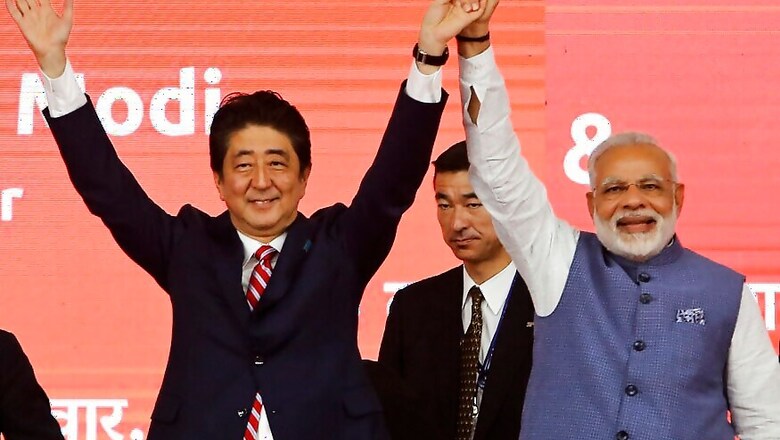
views
New Delhi: There has been a lot of talk about the ‘campaign-like’ atmosphere associated with Japanese Prime Minister Shinzo Abe’s visit to Ahmedabad. A lot of political commentators compared Wednesday’s road show from the airport to Sabarmati Ashram to an election road show.
Many even argued that this was Prime Minister Narendra Modi sounding the political bugle in his home state Gujarat which goes to the polls in two months.
Forget about Modi for a moment, it is Shinzo Abe who needs this visit to shore up his sagging popularity ratings back home. The Abe administration suffered a major setback in July when it lost the Tokyo gubernatorial elections.
A new start-up party, Tokyo First, run by former LDP leader Yuriko Koike, secured a shock victory by defeating Abe’s party, the LDP. For the first time Abe’s invincibility was shaken.
Then in August, there was a major corruption scandal in which Abe’s former defence minister and someone who was being groomed as his successor, Tomomi Inada, was forced to resign.
Abe had to usher in a major cabinet reshuffle, wherein he had to make way for rivals within his own party. Former defence minister Itsunori Onodera was brought back.
Former foreign minister Fumio Kishida was moved to a very powerful position within the party. Many say he may launch a run for LDP leadership next fall, before the general elections.
Back to the scandal that cost Abe’s protégé her job, this involved a famous school Moritomo Gauken in which the allegation was that Abe’s wife Akie Abe had donated a million yen and the government had given land to the school at throwaway prices.
While the probe did not directly implicate Abe or his wife, there is a sense in Japan that the Abes managed to save themselves by the skin of their teeth.
Meanwhile, Tokyo Governor Koike is expected to launch a run for Prime Ministership next year. Her candidature, if it happens, is expected to strike a chord among many Japanese, as her pitch would be to get elected as Japan’s first woman Prime Minister.
If she manages to win, it will be revenge served cold to Abe. After all, Koike left the LDP after a bitter parting of ways with Abe. This explains why major Japanese newspapers on Thursday had front page articles and photographs of Abe with Modi in the roadshow in Ahmedabad. This helps shore up Abe’s popularity ratings which have sunk below 40 percent.
Abe, much like Modi, believes in personalised diplomacy. He was one of the first world leaders to call on US President Donald Trump much before he even formally took over the presidency in January this year.
Abe had managed to control much of the damage caused by Trump’s outspoken comments during the campaign when he said that “Japan must pay for its own security”. Trump had also called for a return of American soldiers serving in Japanese bases.
But all this has gone awry with North Korea’s frequent provocations, including last week’s hydrogen bomb test.
Japan has the most stake in reining in North Korea’s abhorrent behaviour because its security is directly threatened. Abe’s conservative, strongman image threatens to be peeled off by an erratic 31-year-old dictator, Kim Jong-Un, to his immediate west.
Four years on, Abe’s much touted macro-economic policies, coined ‘Abenomics’ have failed to show any magic. The Japanese economy continues to be subdued. Japan’s trade with major partners, including India, has been decreasing in the last few years. It is especially worrying that with both US and Europe showing signs of a turnaround, Japan still continues to lurk dangerously close to deflation territory.
It is clear that if Abe wants a third term beyond 2018, for which the LDP’s party constitution was amended, he could do with all the help he gets. And who better to turn to than his old pal Modi?


















Comments
0 comment